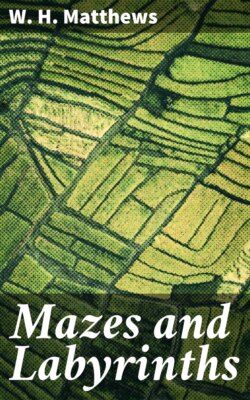Mazes and Labyrinths

Реклама. ООО «ЛитРес», ИНН: 7719571260.
Оглавление
W. H. Matthews. Mazes and Labyrinths
Mazes and Labyrinths
Table of Contents
PREFACE
MAZES AND LABYRINTHS
CHAPTER I. INTRODUCTION
CHAPTER II. THE EGYPTIAN LABYRINTH (i) Accounts of the Ancient Writers
CHAPTER III. THE EGYPTIAN LABYRINTH (continued) (ii) Accounts of Later Explorers
CHAPTER IV. THE CRETAN LABYRINTH (i) The Story of Theseus and the Minotaur
CHAPTER V THE CRETAN LABYRINTH (continued) (ii) The Caverns of Gortyna
CHAPTER VI. THE CRETAN LABYRINTH (continued) (iii) Knossos
CHAPTER VII. THE ETRUSCAN OR ITALIAN LABYRINTH
CHAPTER VIII. THE LABYRINTH IN ANCIENT ART
CHAPTER IX. CHURCH LABYRINTHS
CHAPTER X. TURF LABYRINTHS
CHAPTER XI. TURF LABYRINTHS (continued)
CHAPTER XII. THE ORIGIN OF TURF MAZES
CHAPTER XIII. THE FLORAL LABYRINTH AND THE DWARF-SHRUB MAZE
CHAPTER XIV. THE TOPIARY LABYRINTH, OR HEDGE MAZE
CHAPTER XV. THE TOPIARY LABYRINTH, OR HEDGE MAZE (continued)
CHAPTER XVI. THE TOPIARY LABYRINTH, OR HEDGE MAZE (continued) Latter-day Developments
CHAPTER XVII. STONE LABYRINTHS AND ROCK ENGRAVINGS
CHAPTER XVIII. THE DANCE OR GAME OF TROY
CHAPTER XIX. THE BOWER OF "FAIR ROSAMOND"
CHAPTER XX. MAZE ETYMOLOGY
CHAPTER XXI. LABYRINTH DESIGN AND SOLUTION OF MAZES
CHAPTER XXII. THE LABYRINTH IN LITERATURE
CHAPTER XXIII. MISCELLANEA AND CONCLUSION
APPENDIX BIBLIOGRAPHY OF MAZES AND LABYRINTHS (TOGETHER WITH NAMES OF PERSONS WHO HAVE FURNISHED THE WRITER WITH FIRST-HAND INFORMATION)
I. GENERAL
II. FORM, AND MATHEMATICAL PRINCIPLES
III. THE CLASSIC LABYRINTHS
(i) The Egyptian Labyrinth
(ii) The Cretan Labyrinth
(iii) The Etruscan, Lemnian, etc., Labyrinths
IV. THE LABYRINTH IN ANCIENT ART
(i) Coins
(ii) Pottery
(iii) Mosaic Pavements, etc. (See also Church Labyrinths, Appendix V.)
(iv) Miscellaneous
V. LABYRINTHS IN CHURCHES
(i) General
(ii) Particular Localities
VI. HEDGE MAZES, FLORAL LABYRINTHS, ETC
(i) Classical References (Roman Topiary Work and Ornamental Gardening)
(ii) Great Britain (General)
(iii) Great Britain (Particular Localities)
(iv) France
(v) Italy
(vi) Holland and Belgium
(vii) Other Countries
VII. TURF LABYRINTHS
(i) General
(ii) Particular Localities
VIII. STONE LABYRINTHS (For Rock Engravings, see "Miscellaneous")
IX. THE LABYRINTH IN NON-EUROPEAN COUNTRIES
(i) American Indians
(ii) India
(iii) Zulus
X. MISCELLANEOUS
INDEX
Отрывок из книги
W. H. Matthews
A General Account of Their History and Development
.....
The Labyrinth was designed as a dwelling for, or at any rate was inhabited by, a hideous and cruel being called the Minotaur, a monstrous offspring of Queen Pasiphaë, wife of Minos. The Minotaur is described as being half man and half bull, or a man with a bull's head, a ferocious creature that destroyed any unfortunate human beings who might come within its power. According to report, the youths and maidens of the Athenian tribute were periodically, one by one, thrust into the Labyrinth, where, after futile wanderings in the endeavour to find an exit, they were finally caught and slain by the Minotaur.
When Theseus arrived at the court of Aegeus, having been brought up hitherto by his mother in a distant seclusion, he was distressed to find that his father's joy in the reunion was overcast by a deepening sadness. On inquiring the reason for this, he learned of the vindictive tribute laid upon the kingdom, and that the time for the third payment was approaching.
.....